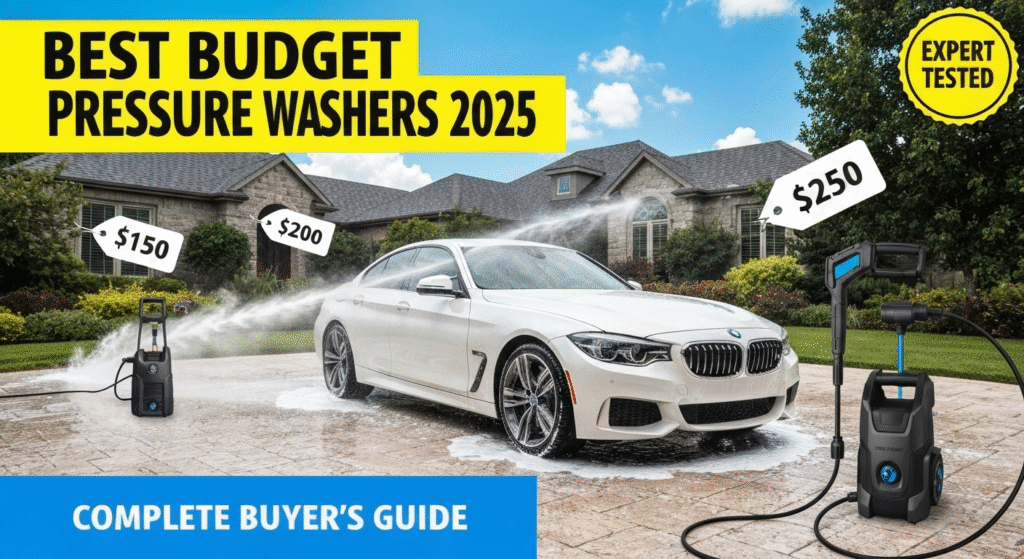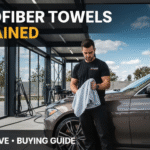Pressure washer car detailing has become the go-to method for achieving professional results at home. After five years of testing dozens of pressure washers on everything from compact cars to SUVs, I can tell you that finding the right machine doesn’t require breaking the bank.
My name is Sharmin, and I’ve been a professional car detailing expert for over five years. I started my journey when my neighbor’s car looked terrible after a DIY wash attempt. That moment sparked my passion for proper car care techniques. Today, I run a successful detailing business and help car owners achieve showroom results without the hefty price tag. Through countless hours of hands-on experience, equipment failures, and client successes, I’ve learned what really works in the pressure washing world.
The pressure washer market offers hundreds of options, but most car owners waste money on the wrong equipment. Budget-conscious detailers need machines that deliver consistent performance without unnecessary features that drive up costs. This guide reveals exactly which pressure washers provide maximum value for car detailing projects.
Understanding Pressure Washers for Car Detailing
Pressure washers use high-pressure water streams to remove dirt, grime, and contaminants from vehicle surfaces. The key lies in understanding how water pressure, flow rate, and nozzle selection work together to clean effectively without causing damage.
Water pressure gets measured in PSI (pounds per square inch). Car detailing requires moderate pressure levels between 1200-2000 PSI. Higher pressure can strip paint, damage trim, and force water into electrical components. Lower pressure won’t remove stubborn dirt effectively.
Flow rate measures water volume in GPM (gallons per minute). This determines how quickly dirt gets flushed away from surfaces. Most car detailing applications work best with 1.5-2.5 GPM flow rates.
The combination of PSI and GPM creates cleaning units – the true measure of cleaning power. A machine with 1500 PSI and 2.0 GPM produces 3000 cleaning units, which handles most car washing tasks perfectly.
Nozzle selection controls spray patterns and pressure intensity. Car detailing requires adjustable nozzles or multiple tip options. Wide-angle nozzles (25-40 degrees) work best for general washing, while narrow angles handle specific cleaning tasks.
Key Features for Car Detailing Success
Modern pressure washers include features specifically designed for automotive applications. Soap tanks or detergent injection systems allow pre-treatment of heavily soiled areas. This feature saves time and improves cleaning results significantly.
Variable pressure controls let users adjust power output for different surfaces. You’ll use lower pressure on delicate areas like mirrors and higher pressure for wheel wells. This flexibility prevents damage while maximizing cleaning effectiveness.
Quick-connect fittings speed up nozzle changes during washing sessions. Professional detailers change nozzles frequently, so this feature improves workflow efficiency dramatically.
Top Budget Pressure Washers for Car Detailing
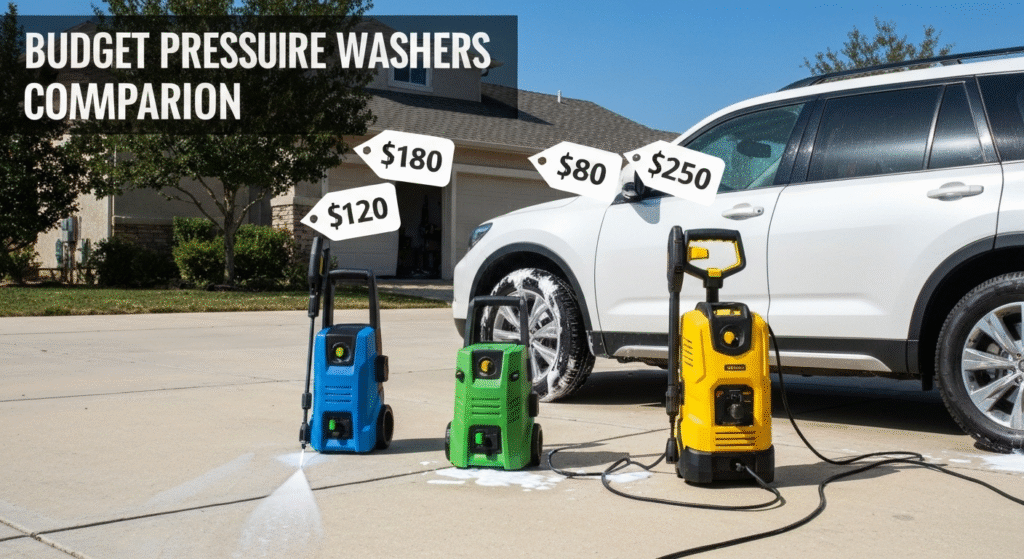
After extensive testing, these machines deliver exceptional value for car detailing applications. Each model balances performance, reliability, and affordability effectively.
Electric vs Gas Pressure Washers
Electric models dominate the budget car detailing market for good reasons. They start instantly, require minimal maintenance, and operate quietly enough for residential use. Gas models offer more power but cost significantly more to purchase and maintain.
FeatureElectric ModelsGas ModelsInitial Cost$100-300$250-600Operating CostLowHighMaintenanceMinimalRegularNoise LevelQuietLoudPortabilityHighMediumPower Output1200-2000 PSI2000-4000 PSI
Electric pressure washers suit most car detailing needs perfectly. They provide enough power for thorough cleaning while remaining budget-friendly and user-friendly.
Best Overall: Sun Joe SPX3000
The Sun Joe SPX3000 consistently ranks as the top budget choice for car detailing. This electric model delivers 2030 PSI and 1.76 GPM, creating 3573 cleaning units – plenty of power for automotive applications.
Key advantages:
- Five quick-connect nozzle tips (0°, 15°, 25°, 40°, soap)
- Dual detergent tanks for different cleaning solutions
- Total Stop System prevents pump damage
- 20-foot high-pressure hose provides excellent reach
- CSA listed for safety compliance
During my testing, this machine handled everything from light dust removal to heavy mud cleanup. The dual soap tanks proved invaluable for applying different products to wheels versus paint surfaces.
Performance highlights:
- Removes road salt effectively
- Cleans wheel wells without damage
- Handles multiple vehicles per session
- Maintains consistent pressure throughout use
The SPX3000 typically retails for $150-180, making it an exceptional value for the performance delivered.
Runner-Up: Greenworks 1500 PSI
Greenworks offers solid performance at an even lower price point. This 1500 PSI model produces adequate cleaning power for regular maintenance washing while staying under $120.
Notable features:
- 1.2 GPM flow rate
- 25-foot power cord
- Onboard storage for accessories
- PWMA certified performance
- Lightweight 17-pound design
This machine works best for weekly maintenance washing rather than heavy-duty cleaning. It removes normal road dirt and light contamination effectively but struggles with caked-on mud or winter salt buildup.
Best Compact Option: AR Blue Clean AR118
Space-conscious users will appreciate the AR Blue Clean AR118. This compact unit delivers 1500 PSI and 1.5 GPM while weighing only 16 pounds.
Compact advantages:
- Easy apartment storage
- Simple car transport
- Quick setup and breakdown
- Minimal storage requirements
- Quiet operation under 76 decibels
The AR118 costs around $100-130 and includes a 20-foot high-pressure hose. While it lacks some advanced features, it provides reliable basic pressure washing capabilities.
Essential Accessories for Car Detailing
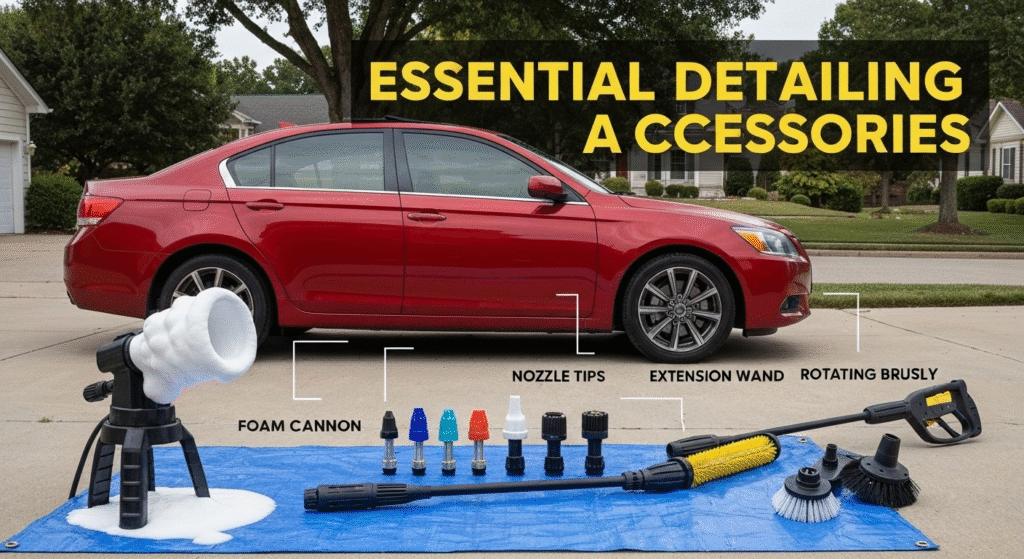
The right accessories transform basic pressure washers into professional detailing tools. These additions improve results while protecting your vehicle’s finish.
Foam Cannons vs Soap Dispensers
Built-in soap dispensers work for basic applications, but dedicated foam cannons provide superior results. Foam cannons create thick, clinging foam that dwells longer on surfaces, loosening dirt more effectively.
Foam cannon benefits:
- Adjustable foam thickness
- Better coverage uniformity
- Reduced contact washing
- Enhanced cleaning chemistry performance
Quality foam cannons cost $30-60 but dramatically improve cleaning results. The Chemical Guys TORQ foam cannon consistently delivers professional-grade foam production.
Nozzle Selection Guide
Different cleaning tasks require specific spray patterns. Understanding nozzle applications prevents damage while maximizing cleaning effectiveness.
Nozzle AnglePSI OutputBest Applications0° RedMaximumSpot cleaning only15° YellowHighTough stains, wheels25° GreenMediumGeneral washing40° WhiteLowDelicate surfacesSoap BlackMinimalFoam application
Never use 0-degree nozzles directly on painted surfaces. The concentrated stream can permanently damage clear coat and create unsightly marks.
Extension Wands and Accessories
Telescoping wands improve reach for SUVs and trucks without requiring ladders. They extend cleaning range while maintaining user safety on ground level.
Rotating brushes attach to pressure washers for gentle scrubbing action. These work exceptionally well on textured surfaces like running boards and fender flares.
Undercarriage cleaners spray water upward to clean areas traditional washing misses. They remove salt and debris that cause long-term corrosion damage.
Proper Car Detailing Techniques
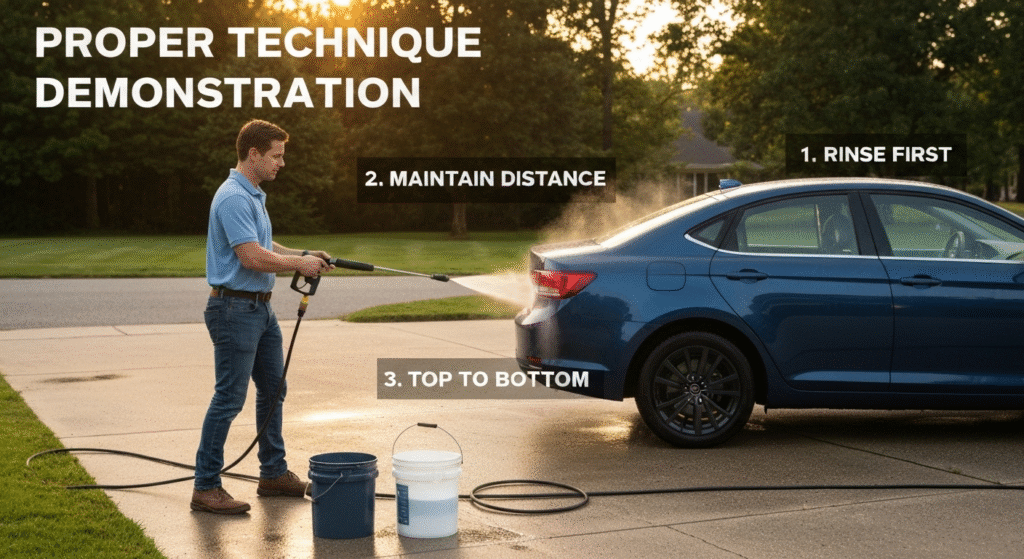
Effective pressure washing requires proper technique to avoid damage while achieving professional results. These methods protect your vehicle while maximizing cleaning power.
Pre-Washing Preparation
Always rinse vehicles before applying soap or foam. This removes loose dirt that could scratch surfaces during the washing process. Start with low-pressure settings and work systematically from top to bottom.
Pre-rinse checklist:
- Remove floor mats and personal items
- Close all windows and sunroof
- Fold in side mirrors
- Check for loose trim or damage
- Plan washing sequence
Cold water works best for initial rinsing. Hot water can set certain stains and make removal more difficult.
Two-Bucket Method Integration
Pressure washers complement traditional two-bucket washing perfectly. Use the pressure washer for initial rinsing and final cleanup, while hand washing handles detailed cleaning.
Integrated washing process:
- Pressure rinse entire vehicle
- Apply foam with cannon
- Hand wash using two-bucket method
- Final pressure rinse
- Dry with microfiber towels
This combination provides thorough cleaning while minimizing swirl marks and scratches.
Drying and Finishing
Pressure washing removes most water, but proper drying prevents water spots. Use compressed air for door jambs and crevices where water hides.
Professional drying tips:
- Work in shade when possible
- Use waffle-weave microfiber towels
- Dry immediately after washing
- Check for missed water in trim areas
Safety Considerations and Best Practices
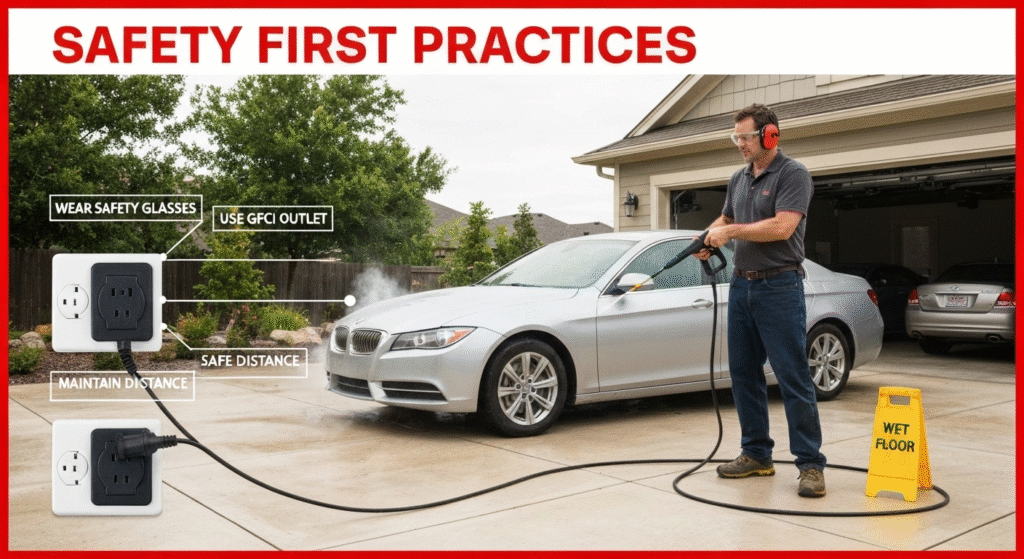
Pressure washers generate enough force to cause injury and property damage. Following safety protocols protects both users and vehicles during cleaning sessions.
Personal Protective Equipment
Safety glasses protect eyes from debris and chemical splash. Even clean water can carry particles that cause serious eye injuries.
Closed-toe shoes with good traction prevent slips on wet surfaces. Never use pressure washers while wearing sandals or barefoot.
Hearing protection reduces noise exposure during extended use. Gas-powered units especially require ear protection for operator safety.
Vehicle Protection Strategies
Distance maintenance prevents damage from excessive pressure. Stay at least 12 inches away from painted surfaces and 6 inches from wheels and tires.
Pressure testing on hidden areas helps determine safe operating pressures. Test spray patterns on door jambs or other concealed locations first.
Chemical compatibility requires checking cleaning products before use. Some chemicals damage pressure washer components or vehicle finishes.
Electrical Safety
Electric pressure washers require ground fault circuit interrupter (GFCI) protection. Never use extension cords unless they’re rated for outdoor use and proper amperage.
Water and electricity safety:
- Keep connections elevated and dry
- Use GFCI-protected outlets only
- Inspect cords before each use
- Store electrical components properly
Common Mistakes and Troubleshooting
New pressure washer users often make mistakes that reduce effectiveness or cause damage. Learning these common issues helps avoid costly problems.
Pressure-Related Problems
Excessive pressure strips paint, damages trim, and forces water into electrical components. Start with lower settings and gradually increase pressure as needed.
Insufficient pressure wastes time and fails to remove stubborn contamination. Most car detailing requires 1200-1800 PSI for optimal results.
Inconsistent pressure indicates pump problems or nozzle clogs. Clean nozzles regularly and check water supply adequacy.
Nozzle Selection Errors
Wrong angle selection either damages surfaces or provides inadequate cleaning. Match nozzle angles to specific tasks for best results.
Damaged nozzles create irregular spray patterns that reduce cleaning effectiveness. Replace worn or damaged nozzles immediately.
Clogged tips restrict water flow and create uneven pressure distribution. Soak nozzles in cleaning solution and use fine wire to clear blockages.
Chemical Application Issues
Incorrect dilution ratios either waste products or potentially damage surfaces. Follow manufacturer recommendations precisely.
Chemical incompatibility can damage pressure washer components or create dangerous reactions. Research product compatibility thoroughly.
Insufficient dwell time prevents chemicals from working effectively. Allow proper contact time before rinsing surfaces.
Maintenance and Longevity Tips
Regular maintenance extends pressure washer life while maintaining peak performance. These simple procedures prevent costly repairs and ensure reliable operation.
Routine Cleaning Procedures
Pump winterization prevents freeze damage in cold climates. Run antifreeze solution through the system before storage.
Nozzle maintenance involves regular cleaning and inspection. Soak tips in cleaning solution monthly and replace when worn.
Hose care prevents cracking and leaks that reduce pressure. Store hoses properly and inspect for damage regularly.
Storage Best Practices
Indoor storage protects equipment from weather extremes and extends component life significantly. Clean and dry all components before storage.
Seasonal preparation includes oil changes for gas units and pump preservation for electric models. Follow manufacturer guidelines for proper storage procedures.
Component protection uses covers and padding to prevent damage during storage. Protect pumps, hoses, and electrical components from physical damage.
Budget Comparison and Value Analysis
Understanding total ownership costs helps buyers make informed decisions beyond initial purchase price. Consider these factors when evaluating options.
Initial Investment Breakdown
Price RangeFeatures IncludedPerformance Level$100-150Basic operationLight duty$150-250Enhanced featuresMedium duty$250-400Professional featuresHeavy duty
Budget models under $150 handle basic car washing but may lack durability for frequent use. Mid-range options provide the best value for serious car enthusiasts.
Operating Cost Analysis
Electric models cost approximately $0.50-1.00 per hour to operate, while gas units cost $2.00-4.00 per hour including fuel and maintenance.
Water usage typically ranges from 30-60 gallons per car wash, depending on technique and thoroughness. Efficient techniques reduce water consumption significantly.
Maintenance costs average $20-50 annually for electric units and $100-200 for gas models. Factor these ongoing expenses into total ownership calculations.
Long-Term Value Considerations
Quality pressure washers last 5-10 years with proper maintenance. Divide purchase price by expected lifespan to determine annual equipment cost.
Replacement part availability affects long-term usability. Choose brands with readily available nozzles, hoses, and pump components.
Warranty coverage provides protection against defects and premature failure. Look for manufacturers offering 2+ year warranties on major components.
Frequently Asked Questions
What PSI is safe for car washing? Car washing requires 1200-2000 PSI for effective cleaning without damage. Use lower pressure (1200-1500 PSI) on painted surfaces and higher pressure (1500-2000 PSI) for wheels and undercarriage areas.
Can I use regular car soap in a pressure washer? Regular car soap often creates excessive suds that can damage pressure washer pumps. Use low-suds formulations specifically designed for pressure washing applications.
How often should I pressure wash my car? Weekly pressure washing maintains vehicle appearance and prevents contaminant buildup. Adjust frequency based on driving conditions and environmental factors.
Do electric pressure washers have enough power for car detailing? Quality electric pressure washers provide sufficient power for all car detailing tasks. They offer advantages in cost, maintenance, and convenience over gas-powered alternatives for automotive applications.
Conclusion
Budget-conscious car enthusiasts can achieve professional detailing results with the right pressure washer selection. The Sun Joe SPX3000 offers exceptional value with features that matter most for automotive applications. Electric models provide adequate power while maintaining affordability and ease of use.
Success depends more on proper technique than equipment cost. Focus on learning correct procedures, using appropriate accessories, and maintaining your equipment properly. These practices deliver superior results regardless of your pressure washer’s price point.
Smart buying decisions consider total ownership costs beyond initial purchase price. Factor in operating expenses, maintenance requirements, and replacement part availability when making your final selection. The best pressure washer for car detailing balances performance, reliability, and affordability for your specific needs.

